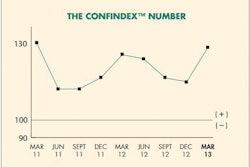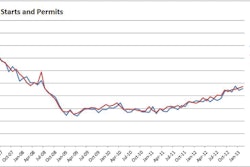Growing labor shortages in all facets of the residential construction sector are impeding the housing and economic recovery, according to a new survey conducted by the National Association of Home Builders (NAHB).
"The survey of our members shows that since June of 2012, residential construction firms are reporting an increasing number of shortages in all aspects of the industry - from carpenters, excavators, framers, roofers and plumbers to bricklayers, HVAC, building maintenance managers and weatherization workers. The same holds true for subcontractors," said NAHB Chief Economist David Crowe.
The survey also found that more than half of the builders reported that labor shortages over the past six months have caused them to pay higher wages or subcontractor bids to secure projects, and consequently, to raise home prices. Moreover, 46 percent of the builders surveyed experienced delays in completing projects on time, 15 percent had to turn down some projects and 9 percent lost or cancelled sales as a result of recent labor shortages.
Part of the reason for the labor shortages can be attributed to the fact that many skilled residential construction workers were forced to seek employment elsewhere during the recession and are no longer currently available.
Construction Employment Emerging from Six-Year Slump
"What used to be high-paying, skilled jobs vanished as builders across the nation went out of business or were forced to let workers go," said NAHB Chairman Rick Judson, a home builder from Charlotte, N.C.
The loss of tens of thousands of housing jobs mushroomed to more than 1.4 million during the peak of the downturn. During this period, many trades retrained construction workers and they are not returning to the residential construction sector.
Meanwhile, a lack of buildable lots and increased costs for materials and labor are also contributing to the problem, as the infrastructure that supports home building moves to re-establish itself following the worst housing downturn since the Great Depression, Crowe said.
New Housing, Nonresidential Renovations Drive Increase in Construction Materials Prices
To help meet the growing demand for skilled labor within the housing sector, the Home Builders Institute (HBI), in partnership with NAHB, provides career training and job placement in the building industry. HBI offers an array of portable pre-apprenticeship training programs in a variety of skilled trades that can be customized to meet the workforce needs of communities across the nation. HB regularly places approximately 80 percent of its student graduates in jobs in the building sector.
"We are ramping up our efforts to train diverse populations and place them in jobs to meet the growing demand of the building sector," said HBI President and CEO John Courson.
"Even in a period of relatively high unemployment, we still need to complement our job training efforts by bringing in foreign workers to meet the needs of home builders and home buyers," added Judson.
The worker shortages are not only slowing the housing recovery, but also hurting job and economic growth.
Nationally, the construction of 1,000 single-family homes generates more than 3,000 jobs, approximately $145.4 million in wages, and more than $89 million in federal, state and local tax revenues. That doesn't even count the increase in annual property taxes that local municipalities rely on to fund schools, police and firefighters.
As the economy mends, pent-up demand for housing will continue to grow, as roughly 2 million household formations were delayed as a result of the Great Recession. In normal economic times, demand for new homes should be about 1.7 million annually.
US Housing Starts Edge Up 0.8% in February, Permits Rise 4.6%
NAHB is anticipating total housing starts of 970,000 this year and 1.18 million in 2014 as the market continues its gradual rebound.
"We need to look holistically at the home building infrastructure to meet growing and future demand," said Judson. "To avoid a run-up in prices in hot markets due to labor issues, we need to complement our current training programs with a market-based visa system that would allow more immigrants to legally enter the construction workforce each year when there is a dearth of workers to fill the jobs that are needed."



















